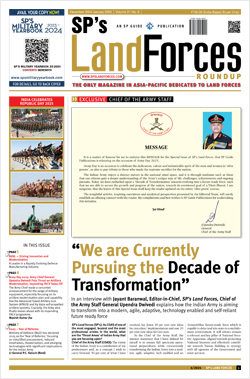INDIAN ARMED FORCES CHIEFS ON OUR RELENTLESS AND FOCUSED PUBLISHING EFFORTS

The insightful articles, inspiring narrations and analytical perspectives presented by the Editorial Team, establish an alluring connect with the reader. My compliments and best wishes to SP Guide Publications.

"Over the past 60 years, the growth of SP Guide Publications has mirrored the rising stature of Indian Navy. Its well-researched and informative magazines on Defence and Aerospace sector have served to shape an educated opinion of our military personnel, policy makers and the public alike. I wish SP's Publication team continued success, fair winds and following seas in all future endeavour!"

Since, its inception in 1964, SP Guide Publications has consistently demonstrated commitment to high-quality journalism in the aerospace and defence sectors, earning a well-deserved reputation as Asia's largest media house in this domain. I wish SP Guide Publications continued success in its pursuit of excellence.
- The layered Air Defence systems that worked superbly, the key element of Operation Sindoor
- Operation Sindoor | Day 2 DGMOs Briefing
- Operation Sindoor: Resolute yet Restrained
- India's Operation Sindoor Sends a Clear Message to Terror and the World – ‘ZERO TOLERANCE’
- Japan and India set forth a defence cooperation consultancy framework, talks on tank and jet engines
- Lt General Pratik Sharma takes over Command of Indian Army's Northern Command
- Major General Lisamma P.V. assumes the appointment of ADG, MNS
- Uzbekistan's progressive transformation is a bright spot in Central Asia; boosts cultural ties with India
- Terrorist Attack in Pahalgam in Kashmir: Unfolding a long surgical war against PAK
Indian Armed Forces want over 400 drones, next-generation weapons
The Indian armed forces over the next decade want over 400 drones, including combat and submarine-launched remotely piloted aircraft, as well as directed energy weapons (DEWs) like high-energy lasers and high-powered microwaves capable of destroying enemy targets and even satellites. Several such military capabilities have been identified in the defence ministry’s new “Technology Perspective and Capability Roadmap-2018” to provide the industry with an overview of the country’s offensive and defensive military requirements up to the late 2020s. This roadmap may guide the industry in planning or initiating technology development, partnerships and production arrangements. While pursuing any development or collaboration, the Indian industry should accord due importance to the government’s thrust towards ‘Make in India’, says the 82-page document.
Apart from obvious necessities ranging from next-generation submarines, destroyers and frigates to missiles, infantry weapons, specialised ammunition and CBRN (chemical, biological, radiological, nuclear) defence systems, the document focuses on a wide variety of unmanned aerial vehicles (UAVs) or drones needed by the armed forces. Drones are major force-multipliers in modern-day warfare for real-time surveillance as well as hitting high-value enemy targets. The armed forces currently have over 200 drones, the bulk of them imported from Israel for long-range surveillance and precision-targeting. They also have some Israeli Harop “killer” or Kamikaze drones, which act as cruise missiles by exploding into enemy targets and radars. Even as DRDO works on developing the Ghatak stealth UCAVs (combat drones) under a 2,650 crore project, the roadmap says the Army and Navy will need “more than 30” combat remotely-piloted aircraft (RPA).
“The medium-altitude, long-endurance (MALE) combat RPA should have the capability to fly up to 30,000-feet altitude, with extended satellite communication ranges and endurance of more than 24 hours,” says the document. The drones should be capable of firing missiles at land and maritime targets from over 20-km away.





